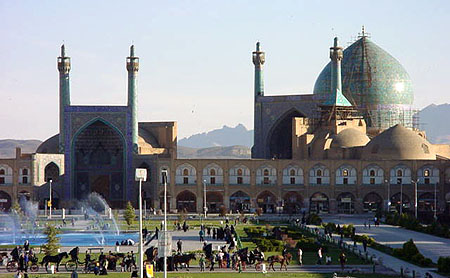HIS 112
Unit 3: Persia, a Gunpowder Empire?

The Shah Mosque in Isfahan was
built at the height of Safavid power in the seventeenth century, during the reign of
the greatest of the Safavid monarchs, Shah Abbas I (1587–1629); currently a
UNESCO world heritage site. Photo source was en.wikipedia.org/wiki/Image:Shah_Mosque_in_Esfahan.jpg.
 What you must do in this unit
What you can do in this unit
What you must do in this unit
What you can do in this unit
- Read the Sample Historical
Document Analysis,
based on some excerpts from Hammurabi's code of law. The sample illustrates some of the questions
that a historian asks when reading a historical document. This is what you will be doing in this course.
- Listen to some further information about this unit
as a mp3 file.
You can also read the information as
a txt file.
Some videos that you can watch for this unit
Extra Credit Options
- Take the short 5-point quizzes for chapters 17 and 22. Log into Blackboard and look under "Chapter Quizzes." You have five minutes to complete each quiz (multiple-choice questions).
- For a maximum of 25 points extra credit, read The Status of Jews
and Christians in Muslim Lands (1772) and in a long paragraph comment upon the nature of Muslim-Jewish-Christian relations in the eighteenth century.
- For a maximum of 25 points extra credit, read François Bernier, An Account of India and the Great Moghul,
1655, and write a long paragraph in which you explain Shah Jehan's style of rule.
- For extra credit of a maximum of 10 points,
you can submit the answers to the Chardin study questions. Please write in formal, complete sentences.
- For extra credit, please suggest a
relevant website for this unit of the course. Send the title of the site, the url and a
brief explanation why you find the information interesting and applicable to
the material being studied this unit.
|

